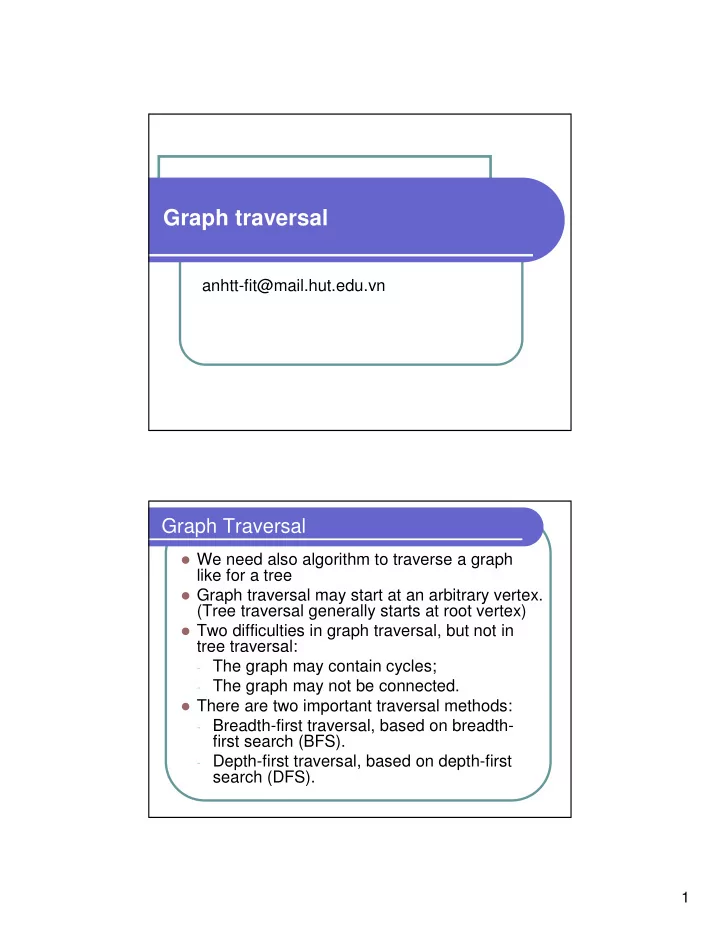

Graph traversal anhtt-fit@mail.hut.edu.vn Graph Traversal � We need also algorithm to traverse a graph like for a tree � Graph traversal may start at an arbitrary vertex. (Tree traversal generally starts at root vertex) � Two difficulties in graph traversal, but not in tree traversal: - The graph may contain cycles; - The graph may not be connected. � There are two important traversal methods: - Breadth-first traversal, based on breadth- first search (BFS). - Depth-first traversal, based on depth-first search (DFS). 1
Breadth-First Search Traversal Breadth-first traversal of a graph: Is roughly analogous to level-by-level traversal of an - ordered tree Start the traversal from an arbitrary vertex; - Visit all of its adjacent vertices; - Then, visit all unvisited adjacent vertices of those visited - vertices in last level; Continue this process, until all vertices have been visited. - 0 8 0 8 9 2 9 2 source source 1 7 1 7 4 4 3 3 5 6 5 6 Breadth-First Traversal The pseudocode of breadth-first traversal algorithm: BFS(G,s) for each vertex u in V do visited[u] = false Report(s) visited[s] = true initialize an empty Q Enqueue(Q,s) While Q is not empty do u = Dequeue(Q) for each v in Adj[u] do if visited[v] = false then Report(v) visited[v] = true Enqueue(Q,v) 2
An Example Breadth-First Search Traversal Example of breadth-first traversal Visit the first vertex (in this example 0) - Visit its adjacent nodes in Adj [0] :7 5 2 1 6 - Visit adjacent unvisited nodes of the those visited in last level - Visit adjacent nodes of 7 in Adj [7] : 4 - Visit adjacent nodes of 5 in Adj [5] : 3 - Visit adjacent nodes of 2 in Adj [2] : none - Visit adjacent nodes of 1 in Adj [1] : none - Visit adjacent nodes of 6 in Adj [6] : none - Visit adjacent unvisited nodes of the those visited in last level - Visit adjacent nodes of 4 in Adj [4] : none - Visit adjacent nodes of 3 in Adj[3 ] : none - Done - 3
Breadth-First Traversal Breadth-first traversal of a graph: Implemented with queue; - Visit an adjacent unvisited vertex to the current vertex, - mark it, insert the vertex into the queue, visit next. If no more adjacent vertex to visit, remove a vertex from - the queue (if possible) and make it the current vertex. If the queue is empty and there is no vertex to insert into - the queue, then the traversal process finishes. Quiz 1 � Let implement a graph using the red black tree as in the previous lab. typedef JRB Graph; Graph createGraph(); void setEdge(Graph* graph, int v1, int v2); int connected(Graph* graph, int v1, int v2); � Write a function to traverse the graph using BFS algorithm void BFS(Graph* graph, int s, int (*func)(int)); // func is a pointer to the function that process on the visited vertices 4
Unweighted Shortest Path Problem � Unweighted shortest-path problem: Given as input an unweighted graph, G = (V,E), and a distinguished vertex, s, find the shortest unweighted path from s to every other vertex in G. � After running BFS algorithm with s as starting vertex, the shortest path length from s to i is given by d[i]. Pseudo Algorithm BFS(G,s) for each vertex u in V do visited[u] = false; d[u]= ∞ ∞ ∞ ∞ Report(s) visited[s] = true initialize an empty Q Enqueue(Q,s); d[s]=0; While Q is not empty do u = Dequeue(Q) for each v in Adj[u] do if visited[v] = false then Report(v) d[v]=d[u]+1; visited[v] = true Enqueue(Q,v) 5
Quiz 1.1 � Continue with the exercise about Metro stations. � Write a function that print out a unweighted shortest path between two given vertices and return its length. int UShortestPath(Graph* graph, int v1, int v2); 6
Recommend
More recommend